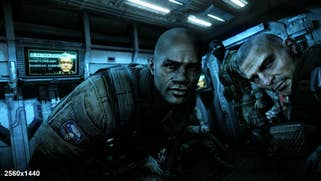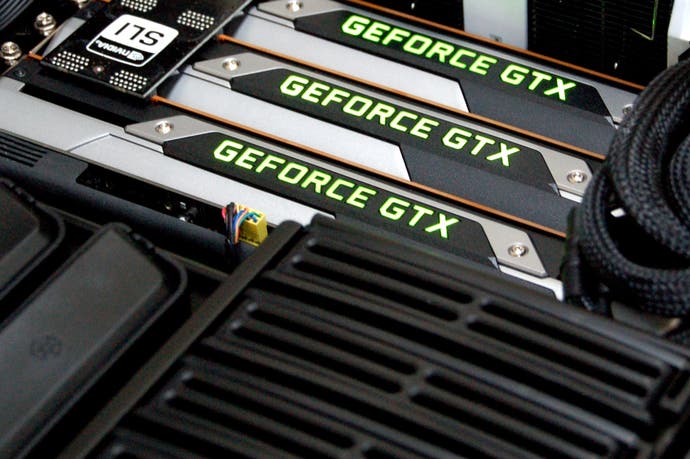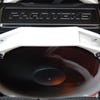Digital Foundry vs. the ultimate gaming PC
Three Titans. Six CPU cores. A generational leap beyond PlayStation 4?
OK, so perhaps there's just a certain level of exaggeration to the title of this article. After all, the strength of PC technology is its astonishing level of scalability, from the humble Intel Atom found in Windows 8 tablets, through dual CPU server set-ups all the way up to the Cray XK7 super-computer with 18,688 16-core AMD Opterons and an equal measure of Nvidia Tesla K20 graphics cards. But if money were no object and you were looking to construct an absolute top-end PC based on consumer level parts, the chances are that the system you'd create would be very similar indeed to what we have here: an Intel Sandy Bridge-E hex-core processor working in concert with three Nvidia GeForce Titans in SLI. That's what Nvidia thought when it commissioned this particular PC, sending it to Digital Foundry to assess what all that power translates into in terms of an actual gameplay experience.
We've covered the Titan before of course. At around £850 it is one of the most expensive graphics cards money can buy, and it's the most powerful single-chip GPU on the market. Computational metrics are difficult to translate into game performance, but the Titan offers a tangible 50 per cent performance boost over Nvidia's previous flagship, the GeForce GTX 680. The fact that it is based on a single processor (rather than two like the GTX 690 or AMD's Radeon HD 7990) allows for additional flexibility and scalability via SLI - the process of adding multiple graphics cards together and combining their power. In theory there's nothing stopping you adding a fourth Titan to the mix, but it's at this point that the laws of diminishing returns kick in savagely - three of these behemoths in parallel should do the job quite nicely.
While the Titans are running at stock frequencies, Intel CPUs are very, very simple to overclock and the 3970X seemed quite happy to run at 4.8GHz, kept within operating temperatures by a meaty Phanteks high performance air cooler. Providing the necessary wattage we have a 1200W Corsair AX1200i power supply while everything is beautifully encased in a Silverstone Fortress FT02 unibody aluminium case. We'd never even considered the merits of a £175 chassis before but this is a superb enclosure with absolutely no compromises to quality we could pick up on. Over and above the aesthetic we particularly liked the way the rear of the motherboard is on the top of the case, the various ports easily accessible and cabling kept tidy via a mesh shroud that clips on once all of your leads are in place.
It is without a shadow of a doubt the most visually striking PC we've seen, but of course, the real appeal of this particular set-up is the sheer level of processing power it offers. If a console generation is defined by a 6x to 8x boost in performance over existing hardware, what this machine could well represent is a generational leap beyond the capabilities of key components in the PlayStation 4. What we have here is a PC that offers up the kind of raw power we may well be getting eight or nine years down the line - if indeed there is a new wave of consoles after the next Sony and Microsoft machines have run their course.
The price of all this technology? Getting it prebuilt by a company like Scan - as Nvidia did - will probably set you back well over £4,000. The EVGA Titans alone account for £2,700 of the bill. A dual Titan system with the cheaper (but still very, very good) Core i7 3930K is currently advertised for £3,771.
So let's take stock - does this "next-gen's next-gen" claim actually hold water? Let's break down this seemingly ludicrous assertion in terms of the core components: obviously the GPU set-up takes centre-stage here. At stock, the GeForce GTX Titan is rated at 4.7TFLOPs up against the 1.84TF in PlayStation 4, a 2.55x factor increase. This is impressive enough in itself, but running three Titans in parallel effectively moves that up to a 7.66x boost in computational power - towards the upper-end of the 6x to 8x increase in performance we expect in moving from one console generation to the next.
Not quite so easy to quantify is the comparison in terms of CPU performance, not least because AMD's upcoming low-power Jaguar architecture has yet to be analysed. Both PlayStation 4 and Durango have eight of these 1.6GHz AMD cores while our PC has six Intel Sandy Bridge-E cores overclocked to 4.8GHz. Clock speed and core count isn't everything though. Intel has proved its complete domination over AMD in single-core performance; combine that with the 3x boost to clock speed and despite the lower core count, we're still looking at what must surely be something approaching the generational leap in performance we're striving for.
Similarly, RAM isn't so easy to pin down. Each of our three Titans has 6GB of GDDR5 memory running at higher clock speeds than the 8GB in the PS4. However, in SLI, memory usage is mirrored on all participating GPUs - we have 18GB of GDDR5 in total but only 6GB is really being put to use. But let's not forget that we also have 32GB of DDR3 at 1600MHz in our system too - not quite an 8x boost over PS4, but in fairness, it could easily be upgraded (we have four spare DIMM slots left). Doing so would be entirely pointless though, unless we set up a RAM disk and copied entire games into system memory. Thinking about it, that might have been quite an amusing experiment.
The memory point raises an interesting question though. The beauty of PC technology is that you can scale it as high - or indeed as low - as you want. The question is, in sinking £5,000 into a gaming computer, are there actually any uses for all that power? Surely nobody would create a graphics engine that would max out a 15TFLOP graphics array in a meaningful way? Well, you might be surprised.
Extreme power and what to do with it
There are fundamental differences emerging between PC and console gaming, much of it centred on the location of gameplay. For console, it's predominantly in the lounge, while PC gaming remains very much a more office or den-based activity. Keyboard and mouse remain the primary interface and that usually involves a desktop being factored into the equation, with the display right in front of you. Valve wants that to change with its Steambox initiative of course, but in the here and now we're looking at two entirely different contexts for the way we play games. Viewed up close, in a desktop environment, resolution matters more. Next-gen consoles are quite rightly targeting the now-standard 1080p HDTV displays we find in the living room, but PC is already moving on.
27-inch 2560x1440 displays start at £250-£300 for Korean imports, offering a 77 per cent increase in resolution over 1080p, and 4x the pixels of standard current-gen 720p. Having purchased a £413 Dell U2713HM for the purposes of testing more capable GPUs, it's proven to be something of a revelation. Once you've upgraded, you'll find it very hard to accept "full HD" again, the difference is so striking. It's not just about the resolution: typically these screens utilise IPS display technology, offering much richer colour than typical PC/laptop monitors or all but the most high-end living room plasmas and LCDs.
But this is just one option. The beauty of PC gaming is that the choice available to gamers is extraordinary. There are supports for 120Hz 1080p displays, meaning you can double maximum frame-rate from 60FPS to 120FPS - resulting in ultra-precision response and an almost unearthly kind of smoothness to gameplay, something to bear in mind when increasing evidence suggests that next-gen console will settle on 30FPS action. If one screen isn't enough for you, why not use three? Set up a trio of monitors in a pseudo-surround configuration with a custom 5760x1080 resolution, or even three 2560x1440 monitors for a mammoth 7860x1440. Field of view isn't just a tweakable in the options menu any more, it's a core element of your hardware set-up and for the most part, it all "just works" on PC, whether you're using AMD or Nvidia cards. Access the GPU control panel, set up a new resolution to cover the multiple screens and it should just pop-up as a selectable in most games.






There's also the small matter of the upcoming 4K standard - in its current HDMI 1.4 configuration, maximum frame-rate is 30FPS, but some of the really expensive displays feature four 1080p60 DVI inputs, each powering a quarter of the screen. So in theory, there's nothing stopping a multi-GPU system providing a cutting-edge 60Hz experience at the very highest resolution. In our recent experiments with a single GTX 680 we got some encouraging results. However, on the three-way SLI Titan set-up, the experience was profoundly improved. Now, obviously 4K is an emerging, extremely expensive standard unlikely to be adopted by many in the short term, but the fact is that PC gaming is so flexible, so scalable, that you plug in the display and it just works.
But let's return to our more affordable, emerging 2560x1440 standard. Is there a game that appears to tax our Titanic PC to its limits? Well, yes. Yes there is.
Can it run Crysis?
For five years, Crysis was the benchmark that defined the cutting-edge in PC performance. The new Crysis 3 is thankfully rather more scalable, but as far as we can gather, it does have the ability to humble any PC that dares explore the very highest of its quality presets. Yes, even our 15 TFLOPs monster.
"There are brutal expectations around the PC version of Crysis 3. So this time we promise to melt down PCs," said Crytek's Cevat Yerli. "There is unfortunately always in a multi-platform development that kind of compromise that we have to take, but at the same time we are trying not to take it, so we try to make sure that the PC version looks fantastic, plays fantastic... This time we're saying, 'Okay, let's not compromise the PC but let's try to push the consoles to make the PC version happen.'"
Run Crysis 3 at 2560x1440 at the very high (maximum) preset with 8x MSAA or 4x TXAA and you'll do so with a marked hit to performance. In our tests, we could only achieve 40-45 frames per second - not quite what we expect from an enormously expensive PC that is effectively the most powerful piece of consumer-level gaming machinery money can buy. Scaling things down to 2x SMAA reduces the computational load and still offers excellent reduction of aliasing, and here is where you get a measure of return on your investment.
"Crysis 3 melts down any PC - even one boasting three Titans and six CPU cores. Minor tweaks to anti-aliasing resolve the issues and the experience is breathtaking."
Alternative Analysis #1: Crysis 3, 2560x1440, 2x SMAA, very high, v-sync - one GTX Titan.
Alternative Analysis #2: Crysis 3, 2560x1440, 2x SMAA, very high, no v-sync - GTX 680 vs. GTX Titan.
Now we aren't going to tell you that Crysis 3 is the best game ever made. The chances are that at the very least you raised a Roger Moore-esque eyebrow at Cevat Yerli's claims that it is a "masterpiece". But in fairness to Crytek's big cheese, you probably haven't played the game in the same way he has. Scaled up to its fullest extent and running on the most powerful hardware available, it is simply a revelation in technological terms. Every nook and cranny has been intricately designed, there is no dead space, the level of detail is simply unprecedented. Lighting, effects, the beautifully rendered organic look to the environments - the sheer scale of some of them... it's breathtaking stuff. Crysis 3 perhaps isn't a game you'll love, but the technological accomplishment is like nothing seen before and for that it deserves some measure of respect.
Things take on a new level once you move up the chain to 4K. The combination of the intricate art style, the attention to detail, the epic post-processing effects work - even though we were limited to the 30 frames per second ceiling of 4K on the current HDMI 1.4 standard, we achieved pretty much a locked, consistent experience and the game looks nothing short of magnificent. We'd always trade frame-rate for pixels, but at a locked 30FPS at 4K with this detail level, the game is breathtaking to behold. Out of interest, we scaled back to one Titan here and found we could achieve the same locked 30 frames per second by moving down to the medium setting. Still a beautiful game for sure, but not really in the same league. Crytek spend $66m on Crysis 3 - Cevat Yerli is probably quite frustrated that the full extent of his team's achievements (not to mention the budget invested) simply won't be seen by most gamers for a very, very long time.
That said, considering the same settings yielded a 30-40FPS performance profile at 2560x1440 on a single Titan, we expected more from three of them. Unfortunately for us, our tests on Crysis 3 took place before the developer released its latest patch, which addresses some SLI performance issues. These are especially prevalent in the first level, where peering through any kind of glass surface caused a 10FPS dip to performance. In the 4K video, you can see that the effects work used in moving the play area out of focus in order to select a new weapon type caused similar issues. Perhaps it also addresses another curious aspect we encountered. Throughout our testing we had the PC plugged into a power meter, producing some fascinating - if not alarming - metrics. This monster drinks at least 160W at idle, scaling up according to load. Across all of our testing we hit about 980W at the max - enough to keep the room heated during the recent cold snap. However, Crysis 3 topped out at around 770W. We had the power to do better but it simply wasn't being utilised.
"The law of diminishing returns kicks in the more GPUs you add to the SLI set-up. Two cards offers the single biggest leap, while four appears to lack much in the way of tangible support."
On this version of the game at least, we reckon that we would have got at least 90 per cent of the experience from two Titan cards in SLI. Take a look at the same level running on one Titan and you'll see that we should really be hitting 80-90FPS with ease here if we were getting a decent level of scalability across all three cards. Turning off v-sync unlocks the frame-rate, giving us some idea of the full power we do have available and we never hit 70FPS. Moving onto 4K resolution, the same process only yields us around 38FPS on average. Maybe the recently released patch addresses that. After all, Crysis 2 - running on the same engine - could easily sail past the 900W level, with 4K frame-rates averaging well above 60FPS, peaking at 90FPS. Here the power drain lends evidence to the theory that we're utilising the potential of all three cards.
All of which opens up an interesting new debate and one of the reasons we were keen to produce this piece. How scalable is SLI generally? Does investing two or three times the money in your graphics hardware result in an equal scaling of performance? Similarly, away from Crysis 3, to what extent can we max out this system using actual game technology?
Maximum performance
Our first test was a return to some unfinished business - a re-run of our circa 2008 grail quest - running Crysis at 1080p at 60 frames per second. At the time, Nvidia's dual-chip GeForce GTX 295 couldn't get close to realising the dream, not even with anti-aliasing disabled, and not even by moving on to the more optimised Crysis Warhead. With this PC, we can run Crysis at a completely locked 1080p60 with 16x AA and we're barely drawing 350W from the mains.
Having already ascertained that we could run Crysis 2 at anything up to 90FPS at 4K, we tried another of our GPU benchmarks - Battlefield 3. The testing Operation Swordbreaker level that still manages to drop frames at 1080p/ultra on a GTX 680 soars to 70-90FPS at 4K. What's especially impressive on Battlefield 3 especially is that the many of the ultra settings are not really essential at 4K. The sheer wealth of pixels makes the deferred multi-sampling anti-aliasing seem somewhat redundant - post-process alone looks just fine.
Moving on to our other testing, let's cut to the chase and unleash this monstrous system across a range of in-game benchmarking tests, with v-sync disabled to really see what the PC is capable of. We ran the tests three times: first with just one Titan at 2560x1440, then with SLI engaged, in order to get an idea of how performance actually scales. Then, finally, we re-ran all the tests again - this time in 4K resolution. The games we chose include a range of PC staples along with titles like Sleeping Dogs and Hitman Absolution, where performance on max settings has been known to bring enthusiast PCs to their knees.
"The Titan SLI set-up produces excellent results on virtually all gaming benchmarks - even on settings so absurd you're unlikely to use them during gameplay. It comes into its own at extreme resolutions and multi-monitor gameplay."
| 2560x1440 GTX Titan x1 | 2560x1440 GTX Titan x3 | 3840x2160 (4K) GTX Titan x3 | |
|---|---|---|---|
| BioShock Infinite, DX11 Ultra | 65.1 | 139.4 | 80.5 |
| Tomb Raider, Max Settings, FXAA, TressFX On | 54.0 | 80.9 | 39.3 |
| Metro 2033, Max Settings, 4x MSAA, PhysX On | 29.0 | 74.5 | 36.0 |
| Batman Arkham City, Max Settings, 32x CSAA, PhysX Max | 56.0 | 82.0 | 66.0 |
| Hitman Absolution, Max Settings, 8x MSAA | 30.9 | 68.0 | 42.7 |
| Sleeping Dogs, Max Settings, SSAA+FXAA | 34.1 | 93.2 | 41.7 |
| Crysis GPU Test, DX10, Max Settings, 16x AA | 37.8 | 83.3 | 45.6 |
To add to the fun, we captured the proceedings on one of our prototype Ultra-HD workstations while the Titan SLI machine went about its business. This gives you some idea of what's actually being rendered on-screen to bring about these benchmarks. The Hitman Absolution test is quite something.
In terms of SLI scalability, it's interesting to note that the two biggest performance disappointments - Batman: Arkham City and Tomb Raider - are the games where we had PhysX (High) and TressFX engaged. Turning them off appears to see an improved level of scalability. Elsewhere we see anything from a 2.2 to 2.8 increase in performance with SLI engaged across the three cards: some games clearly scale better than others, but we get the feeling that most optimisation is at the 2x SLI level, with more modest gains on average as we move to three. For the ultimate in Titan SLI testing, Newegg TV's four-way Titan benches demonstrate that the law of diminishing returns kicks in at three Titans, with the introduction of a fourth being borderline pointless in most applications.
SLI is something we hope to return to in a little more depth in the future, but we'll leave you with this enticing takeaway: the GeForce GTX Titan is an £850 graphics card, capable of some phenomenal performance - but it is a massively expensive luxury. With a sweetspot in price vs. performance defined by using two cards in SLI, the chances are that you can attain Titan-level frame-rates on a great many games by operating a dual GTX 660 Ti set-up. We reckon that's a saving of around £420.
"On paper we may well have the computational might to offer a next generation leap over the PlayStation 4, but the reality is that we don't have the dedicated software to actually put that power to the best possible use."
Alternative Analysis: Game engine benchmarks re-run at 3840x2160 (4K).
The ultimate games PC: the Digital Foundry verdict
It's difficult to fully assess this remarkable array of PC componentry. On paper we may well have the computational might to offer a next generation leap over the PlayStation 4, but the reality is that we don't have the dedicated software to actually put that power to the best possible use.
We are taking current-gen games and scaling them up as much as we can via higher quality presets, and in many cases the sheer computational effort required isn't directly proportional to the increased quality in the overall experience. Take Sleeping Dogs for example: it's combining super-sampling anti-aliasing with post-process AA for an ultra-pristine presentation - at 4K no less - but we'll never see such an approach in a console game where cost is always measured against the quality of the result. If game coders were actually targeting 15TFLOPs, those resources will be deployed elsewhere - indeed, the horsepower is there to deploy entirely new rendering paradigms.
Overall, putting this kit through its paces has been a remarkable experiment, occasionally thrilling - particularly in the case of Crysis 3 where the experience is genuinely transformed - but ideally, what we'd really like to do is revisit this PC in a year or two year's time and see what this phenomenal piece of machinery can offer over and above the next-gen Xbox/PlayStation 4 console experience, once we have some idea of the standard set by these new pieces of hardware. But of course, by then, the set-up we have here will have been surpassed with even more powerful technology.
In the meantime, what best sums up our time in testing this hardware is the way in which it emphasises what we love about PC gaming - the ability to "roll your own" experience, leaving behind the confines of 1080p and 30FPS, exploring 4K, cranking up temporal resolution to 120FPS, or running gameplay across multiple screens - and in the case of this PC, doing any or all of that without having to compromise the quality of the experience. While this year we'll see initiatives designed to bring the PC into the living room and closer to the mainstream, this phenomenal machine is a love letter to the niche, to the hardcore, to the enthusiasts who demand something different, something unique.











